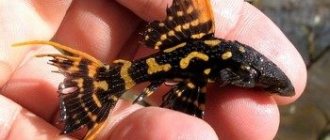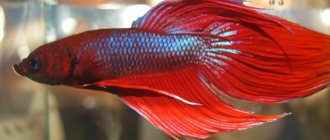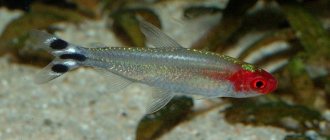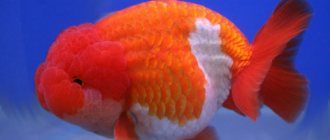The common stargazer or, as it is also called, the European stargazer, or seabird, is a species of fish from the stargazer family.
They are representatives of ray-finned fish from the order Perciformes. Ordinary stargazers are sea-dwelling bottom predators. They have no commercial significance, and to date have been too poorly studied.
European stargazers got their name literally “for their beautiful eyes.” The stargazer's eyes are located at the top of the head and close to each other. As a result, it seems that they are constantly raised to the sky.
The European stargazer can be found in the coastal zone of almost all oceans, but most often they are found along the shores of the Mediterranean Sea, on a sandy or muddy bottom, where they sometimes bury themselves up to their eyes.
The common stargazer prefers to hunt for worms, mollusks, crabs and small fish. To do this, he motionlessly lies in wait for his prey, which inadvertently approaches the astrologer.
Common stargazer (Uranoscopus).
The body of the common stargazer has the shape of a spindle and its length can reach 35 cm, although in most cases the length of the stargazer is around 20 cm.
In addition, the European stargazer has poisonous spines, which are located behind the gill covers above the pectoral fins. It must be said that these spikes, in the event of a collision with a bather, can pose some danger to the latter.
The common stargazer has a wide, thick head covered with bony scutes and small, upward-pointing eyes.
Appearance and gender differences
The stargazer has a round, ovoid body with a low back, the profiles of the head and back are smoothly connected. Telescopic eyes are directed slightly forward and upward. The dorsal fin is missing, the caudal and anal fins are forked. All fins are short. The edge of the upper blade of exhibition fish should not be lower than the line of the back. There is a veil form of the celestial eye. Although this is considered a deviation from the ideal, these fish are very beautiful. Stargazers are often orange-golden in color. Stargazer up to 15 cm in length.
Reproduction
Spawning takes place mainly in early spring at medium depths. In the northern borders of the range it continues until the end of summer. One large female is capable of laying up to 60,000 eggs with a diameter of about 2 mm. There are usually 2 times more males. They find friends thanks to the weak electric field surrounding their bodies.
They feed on plankton, and as they develop, they move to shallow water. There they hide on the ground overgrown with algae and continue to lead a predatory lifestyle. Having reached a length of 5 cm, the fry burrow into the sand like their older comrades.
Young fish grow quickly. In the second year they grow to 15-20 cm and become sexually mature.
Conditions of detention
Stargazer goldfish kept in an aquarium with a volume of at least 50 liters per fish; it is better if it is an aquarium of at least 100 liters, in which a couple of fish will be placed. By increasing the size of the aquarium, the population density can be increased slightly, so 3-4 fish can be placed in an aquarium with a volume of 150 liters, and 5-6 in a 200 liter aquarium, etc. But with increasing population density, attention should be paid to good water aeration. These aquarium fish love to dig into the soil, so it is better to use pebbles or coarse sand as it, then it will not be so easy for the fish to scatter it. The aquarium itself should be spacious and have a view, in which large-leaved aquarium plants should be placed. However, stargazers quickly spoil delicate plants, or the surface of the leaves becomes contaminated by settling particles of waste suspended in water on them. To avoid this, plant plants with a strong root system and hard leaves in the aquarium. Plants such as egg capsule, vallisneria, sagittaria, or elodea are very suitable, as they are the most hardy. Goldfish - celestial eye are kept in the same aquarium along with calm species of aquarium fish. The aquarium must have natural light and good filtration. All varieties of this species prefer good aeration. Fish are not particularly sensitive to the water parameters in the aquarium. For example, permissible temperature fluctuations can range from 18 to 30 °C. However, the optimal temperature in spring and summer is considered to be 18 - 23 °C, and in winter - 15 - 18 °C. Water hardness should be 8 - 25°, with an acidity of 6-8. If your fish begin to feel unwell, you can add 5-7 g of salt per liter of water to the water, as they tolerate water salinity up to 12-15%. It is advisable to change some of the water in the aquarium regularly. Stargazers are unpretentious when it comes to food; they eat a lot of everything. Their diet should contain both living and plant foods. They require less protein than tropical fish of this species and more carbohydrates. Therefore, many companies produce a special diet in the form of granules and flakes specifically for feeding these fish. If you use them regularly, you can get good results, because in addition to the necessary nutrients containing a large proportion of carbohydrates, these foods are balanced and contain natural additives that help improve the yellow, red and orange color of the fish. It is very important to know that dry food should be given in small portions several times during the day. Otherwise, when the food enters the fish’s esophagus in a humid environment, the food swells and greatly increases in size, causing constipation and other disturbances in the normal functioning of the fish’s digestive system. As a result of this, she may die. You can first hold the food in water for 10 seconds - if it is flakes, and 20-30 seconds - if it is granules, and only after that give it to the fish. Despite the gluttony of goldfish, you should not overfeed them. The amount of food they consume daily should be approximately 3% of the fish's weight. Adult fish should be fed twice a day - the first time early in the morning, and the second time in the evening. The amount of food is calculated for 10-20 minutes of feeding, then the remains of uneaten food are removed from the aquarium. Adult fish that receive proper nutrition can endure a long week-long fast without harm to their health. Stargazer goldfish live for about 15 years.
Electrical organs of the common stargazer
Representatives of the genus Stargazers, along with Aastroscopus, are the only perciformes known to science that have electrical organs. In the two genera they developed from different muscles, indicating that they arose independently of each other. In total, to date, only eight cases are known in which these organs appeared independently.
As a rule, when two related species possess such organs, this is explained by the fact that they were inherited from the same common ancestor in which they first appeared. Subsequently, they can develop in their own direction in each inherited species. However, in the case of ordinary stargazers the situation is completely different and much rarer: the electrical organs are their own property.
It is assumed that ordinary stargazers have electrical organs.
Among the inhabitants of the sea, such organs are not so rare, however, among the bony fish living in the marine environment, they were found only in representatives of the family of stargazers and eel-tailed catfish.
In the common stargazer, the electrical organs were formed from the muscles of the swim bladder. According to the researchers, the voltage is only a few hundredths of a volt. “Minus” is located in the front, and “plus” is located in the back. Electrical impulses are generated almost exclusively during feeding and when restless.
Among electric fish, the common stargazer stands out in that it does not have the ability of electroreception. As a result, they are unable to probe their surroundings using electrical discharges, and they are extremely weak to immobilize their prey. As a result, the purpose of these electrical organs remains unclear. This looks especially mysterious in light of the fact that these organs arose in two species of the same family at once. Be that as it may, more than one researcher of these amazing fish has yet to puzzle over this mystery.
Among electric fish, the common stargazer stands out in that it does not have the ability to perceive electrical signals.
The discharges of an ordinary stargazer resemble those of a diamond stingray. It is worth noting the fact that an ordinary stargazer buried in the sand gives these discharges every time a stingray swims over it. Researchers suggest that in this way an ordinary stargazer impersonates a stingray, thereby informing it that the place at the bottom is occupied.
Breeding
All goldfish - celestial eyes can spawn in an aquarium with a capacity of 20 - 30 liters. It is necessary to place sandy soil in it and plant small-leaved plants. For spawning, it is customary to place one female on two or three two-year-old males. Before spawning, they should be kept separately for 2-3 weeks. In the spawning aquarium, it is recommended to maintain the temperature at 24 - 26 ° C. To stimulate spawning, it is necessary to gradually heat the water until its temperature rises by 5-10 °C. At the same time, the males begin to quickly rush around and chase the females, who lose their eggs, scattering them around the entire perimeter of the aquarium, mainly they end up on plants. In total, the female lays about 10,000 eggs. As soon as the spawning is over, the producers must be removed from the aquarium. The initial food for the hatched fry will be “live dust”. They can also be given special food, which is now available in abundance on the market, intended for feeding goldfish fry, for example, Sera Mikron.
Liked? Share with your friends!
Social buttons for Joomla
Secrets of hunting a sea monster
The stargazer's diet consists of small fish, crabs and other small sea creatures that have the misfortune of being near him. It does not use an electric organ to catch prey. Its main function is to protect the astrologer from anything that could pose a threat to life and health.
When hunting, the stargazer relies on his camouflage: he lies buried and waits for a small fish to swim next to him. As soon as the prey is within reach, the observer rises from the sand and instantly swallows it whole. When the stargazer grabs prey, it acts with great speed. Using its huge mouth, it creates a vacuum and simply sucks in food.
Stargazer fish or celestial eye. The fish that saw a nuclear explosion.
Today I will tell you about an unusual pet - this is the stargazer fish or the heavenly eye fish.
Why did I choose these goldfish?
Goldfish are very beautiful. In addition, I was sure that stargazers are quite unpretentious creatures. Next I will dispel this myth.
Place of purchase: Bird market. Let me tell you right away that this is not the best place to buy fish. They will tell you all sorts of nonsense about the contents and pour fish into a bag that are on the edge of the grave.
Appearance.
Of course, I was attracted by their appearance. Huge, protruding eyes facing the sky. Beautiful golden backs shimmer in the sun.
You know, these fish would look equally good at the scene of an emergency.
The stargazer fish has two states - either wide-open eyes and a gaping mouth, as if it sees a nuclear explosion every minute.
The eyes of the fish are bulging, the pupils look up. This makes it seem like she is looking at you all the time. If there are a lot of them, then you may get the feeling that you are being watched. They watch and judge.
Pay attention to the ground. There should be no sharp shells or pebbles
The structure of the eyes of the stargazer fish does not allow it to fully observe the surrounding reality, therefore, without noticing the sharp edge of a snag or pebble, it can get hurt and literally give itself a black eye. The eye is partially deflated.
Feeding
These goldfish are very voracious. But you shouldn’t overfeed them!
Food should be given in small portions so that it does not clog the aquarium. I am not an experienced aquarist. My previous goldfish were fed flies caught on the window, so I simply gave them the dry food recommended by the seller. Flies, you know, are not the same anymore.
But it's not right! You need to alternate dry food with wet food!
Aquarium
There were rumors that fish could develop squint from round aquariums, but the celestial eye is no longer scary for a fish.
The volume of the aquarium for a pair of such fish should be 100 liters. This is a lot.
Let me explain for my most inquisitive little readers, I did not place the fish in glasses or goblets, nor did I use them as an additive to martinis. They are so looking forward to being transplanted into a clean aquarium.
Aeration.
Oxygen must be turned on 24 hours a day. I had the simplest system.
If you decide to get fish, it is better to first take the trouble of buying an aquarium, soil and aeration system, and then get yourself pets.
Compatibility.
Stargazers are extremely harmless creatures, but very clumsy and unable to defend themselves. Therefore, it is risky to place them with other fish. They can easily suffer from aggressive neighbors or go hungry if the neighbor turns out to be more voracious. I kept them together with telescopes. They didn't fight.
When the fish grow up, their pouty eyes will become even larger. And these strange creatures will present an even more amusing sight.
My fish never made it to the big aquarium. The heat of 2010 killed them.
During that hot summer, I had to place bottles of ice in the tank to keep the water cool. But that didn't help either. The fish died unable to withstand this suffocating heat.
Fish are quiet creatures, very beautiful and very gentle. Remember that any pet is a big responsibility. It is always very disappointing to lose pets, so if you are not confident in your abilities, it is better to get electronic ones.
Here you can read about the other pets I kept:
Description of predatory fish
The body of the astrologer reaches 30 cm in length and has the shape of a spindle. The upper part of the fish is colored brown, which allows it to remain unnoticed during the hunt. Stargazer is a predator, so he prefers to eat small fish and shellfish
Also, the fish will not refuse worms that inadvertently approached the place of its hunting. Small scales cover the body, its shade merges with the sand
All this makes the predator invisible and contributes to a successful hunt.
If anyone has ever seen this representative of marine fauna, we assure you that he will remember the encounter for a long time. After all, the stargazer fish has a very terrifying appearance:
- Close, convex eyes, looking up.
- A slightly open mouth with a row of small sharp teeth.
- Protruding lower jaw.
- The dorsal fin is black with four spines.
- The presence of long poisonous spines on the gills.
- There are poisonous spines above each pectoral fin.
The stargazer fish, a photo of which can be seen below, is capable of harming a person who accidentally steps on it with its poisonous spines
Therefore, you need to be careful when relaxing at sea.











